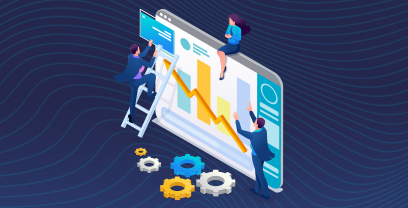In a world of ever-growing economic uncertainty, procurement is at the heart of organizations’ aim to drive efficiency and cost savings. The rise of AI technology combined with Source-to-Pay (S2P) digitization are becoming key allies for leading procurement teams in their quest for ever smarter workflows, improved insights, and data-based decision-making.
As more and more companies invest in S2P technology, Ivalua has commissioned a survey and report on “The State of Source-to-Pay Digitization 2025” from trusted research and advisory firm Ardent Partners.
This blog provides an overview of the most significant insights and best practices to make your procurement teams future ready.
Key Takeaways:
- Driven by market uncertainties and the pressing need to find more savings, more procurement leaders plan to invest in S2P technology.
- Analysts see a growing shift toward broader, integrated platforms and suites.
- AI capabilities are a major factor when choosing procurement technology, with the promise of unlocking unprecedented levels of efficiency, cost-savings and data-based decision-making.
- Accurate, centralized data is the foundation of AI readiness and automation.
CPOs in 2025: Leading Through Uncertainty under Ever Growing Pressure
Tariffs, geopolitical tensions, climate change and inflation…. amid growing uncertainty, CPOs face ever stronger pressure and 90% of respondents expect 2025 to be even more challenging than last year.
In this context, it is not surprising that the main concern for procurement leaders in 2025 is cost savings (reported by a whopping 71% of respondents as the top priority) followed by supply risk mitigation and digital transformation.
Unlike inflation, which has historical benchmarks, the newly announced U.S. tariffs and potential retaliative measures in other regions present unique challenges due to their scale and unpredictability. This makes it difficult for procurement teams to assess their impact or plan responses. Many executives are therefore adopting more cautious investment strategies, and put greater emphasis on cash management and cost-savings.
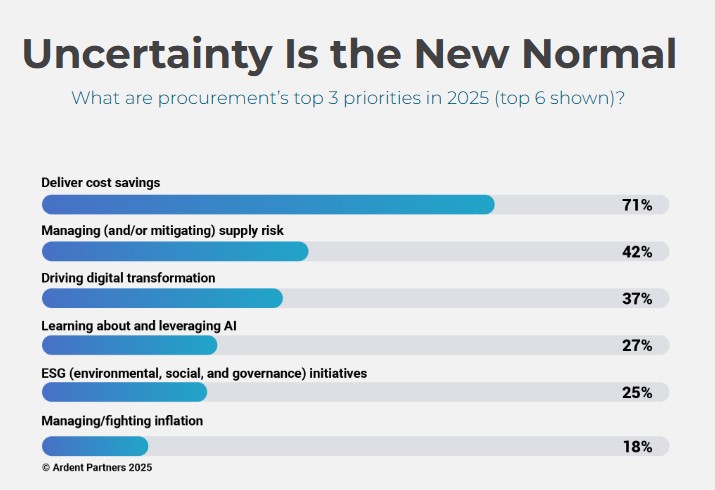
Source-to-Pay Digitization Accelerated
Powerful Source-to-Pay platforms can help digitize, streamline and automate procurement processes, deliver insights into spending patterns and thus help make more informed decisions.
As more and more CPOs turn to digital procurement platforms to help their teams manage spend and generate value, the focus on digital transformation intensifies. Nearly 50% of survey respondents are planning digital transformation efforts (up from 30% last year) while almost a quarter of procurement teams have made using new AI technologies a top strategy in 2025.
The benefits of S2P Digitization
The reasons for this push for digital transformation are clear: procurement leaders whose organizations have already implemented Source-to-Pay technology report significant benefits such as greater efficiency, more spend under management, higher compliance rates or better stakeholder relationships to name just a few. Innovative AI-powered spend analytics tools, conversational interfaces and agentic AI assistants are taking procurement to the next level, fueling what Ardent Partners calls “AI FOMO,” the fear of missing out on AI innovations.
Discover the magic of a conversational interface in our on-demand webinar “AI-Powered Procurement Orchestration and Execution”.
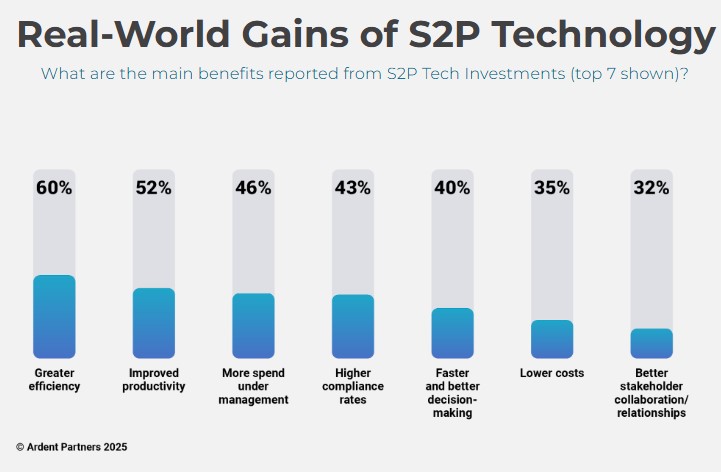
That said, procurement technology implementation can only bring optimal results when the new solution can seamlessly integrate with existing tech stack like ERPs etc., and is used consistently across an organization.
It’s Time to Accelerate Digital Transformation in Procurement
Despite the (almost) unlimited potential of innovative technology, many organizations still struggle with a skills and knowledge gap as to how to or which new procurement automation technologies to use.
According to the Ardent Partners survey, fewer than half of all procurement teams have established what should now be considered essential capabilities.
Additionally, different, sometimes outdated, legacy systems often result in duplicate, incoherent data and a lack of synchronization and cooperation between different departments while manual processes can be slow and a source for human error.
This lack of modernization limits the ability to fully leverage digital solutions, scale best practices and operate efficiently. In short, it prevents many procurement teams from running at full steam and bringing strategic value to their companies.
Pro tip:
Before embarking on a procurement transformation journey, be sure to assess all current processes, tools and organizational capabilities to define where and what needs to be changed, improved, consolidated or, simply, abandoned. Then you can confidently start choosing the right procurement software and building a roadmap.
Download our Source-to-Pay Implementation Guide
S2P Digitization: Adoption Trends and Investment Priorities
More than half of the survey respondents indicate plans to invest in procurement technology in 2025, with 53% even reporting a budget increase for this year. This is a significant uptake compared to last year’s 30%.
2025’s priorities are mainly in supplier management software (information, risk, and performance) to create more value through better communication, tracking, and collaboration with suppliers.
Powerful supplier risk management solutions are vital to ensure compliance while performance tracking will help make supply chains more resilient as weak links can be spotted by AI-powered procurement analytics tools and then pro-actively addressed.
Discover proven strategies to mitigate supplier risks in our latest blog on Supplier Risk Management (SRM). And for deeper insights and best practices, watch these clips from our webinar on “Proactive Risk Management in a Changing Landscape”.
The move towards User-friendly, AI-Powered Suites
As for those who have recently implemented new technology, a full 35% opted for Procure-to-Pay (P2P) suites to manage their spend operations while another 21% have implemented a complete Source-to-Pay suite. This indicates a growing shift toward broader, integrated platforms rather than a fragmented best-of-breed approach.
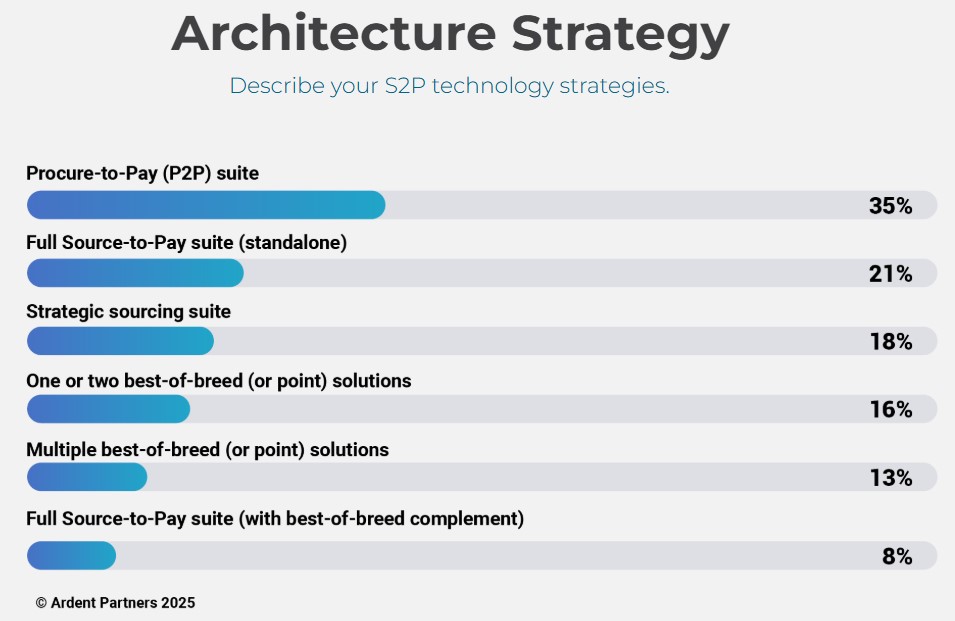
What Matters Most: CPO’s Top 3 Criteria for Choosing S2P Tech
With cost-saving being a major priority for companies, and procurement teams in particular, pricing models, whether fixed license, subscription, or pay-per-transaction, as well as total cost are one of the first criteria on CPOs’ checklist. When evaluating a new solution, they take into account budget as well as expected usage patterns.
To get the best use out of a solution, whether standalone or full suite, widespread adoption is critical which is why usability and user experience are a major point as well, selected by 34% of respondents as evaluation criteria. And they are right: according to almost 30% of respondents, poor user adoption is one of the key issues that can limit the ROI of a new solution.
According to 26% of respondents, AI capabilities within a solution are among the top 3 evaluation criteria as well. Let’s find out why:
AI – CPO’s Most Promising Performance Multiplier
AI has almost unlimited potential and AI is here to stay. Nearly half of all interviewed CPOs report using AI in some form today while 49% of CPOs are planning to adopt AI in the next 12 months.
There is overwhelming consensus that the use of AI is a “positive and necessary development for the future of procurement”, making AI adoption an increasingly strategic priority.
Ardent Partners is predicting that “by the end of 2025 (…) some level of AI capability will be available in nearly every S2P suite or best-of-breed application.”
AI in Procurement: Goals, Use Cases, Challenges
At the time of the survey, roughly one in four procurement teams had integrated some form of AI into their standard procurement activities. The most common use cases include S2P system chatbots, supplier discovery, spend analysis, and contract analysis, while more strategic and qualitative areas are seeing slower uptake.
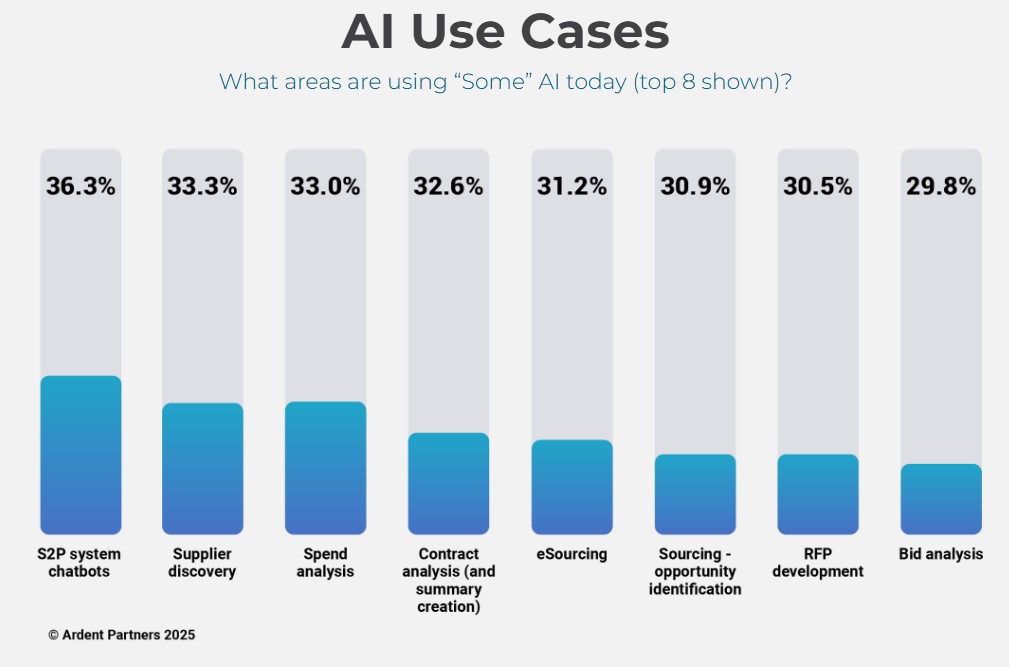
Beyond automating tasks and processes, almost every other procurement leader expects to leverage AI for strategic decision making.
Increased productivity, efficiency, cost savings and better forecasting capabilities are increasingly making AI a strategic asset rather than a ‘nice-to-have’.
Despite obstacles like lack of budget, skills or integrated, interoperable tech stack, these capabilities help CPOs redefine how their teams get results and generate value beyond costè-savings.
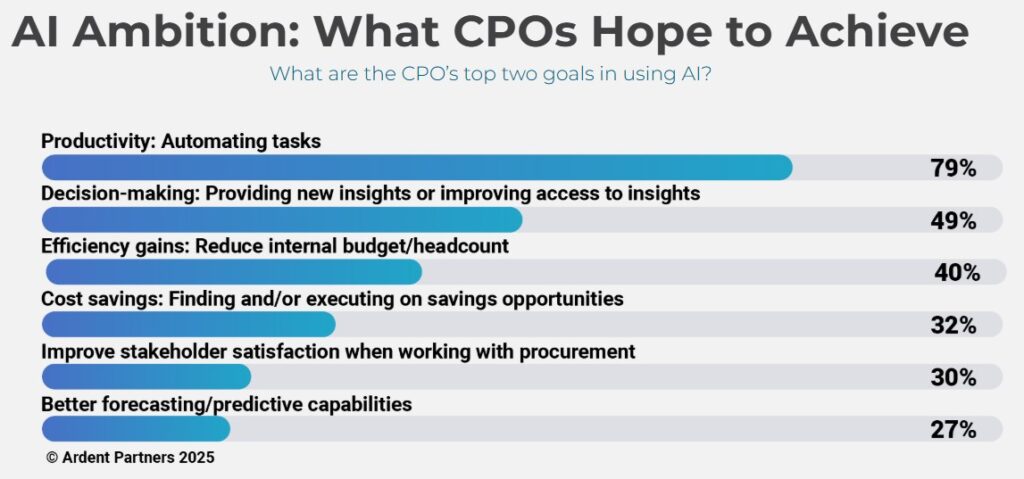
There is one caveat though: the most powerful (AI) technology is only as good or reliable as the data it is fed. And this is a major challenge for many organizations. Let’s find out more.
Data: Procurement’s Greatest Opportunity—and Weakest Link
Top issues limiting the return on investment of an S2P project are poor data, weak integration and underutilization.
According to Ardent Partners research, the vast majority (92%) of procurement leaders consider accurate master data to be either mission critical, extremely important , or very important (18%) to their business from both an operational and financial perspective.
And yet, CPOs “report that, on average, only 63.9% of their overall master data is accurate, complete, and current”. What’s more, less than 10% of procurement leaders use data architecture, quality, and access as a top criteria used in selecting an S2P solution.
Accurate Master Data – The Key to Procurement Success
Poor data quality is one of the key factors preventing S2P technology from delivering its full return on investment.
Spread across multiple systems including duplicates or missing details, owned by different teams, inconsistently formatted, and rarely maintained with rigor – poor data doesn’t just slow you down.
It creates friction at every stage of the S2P cycle, making it harder to scale, move fast, and deliver reliable results or analyses. With costly consequences.
It is therefore vital that procurement teams make reliable master data one of their top priorities when embarking on an S2P transformation project.
Only accurate, centralized data can deliver organization-wide visibility and help streamline workflows to reduce inefficiencies. It is the foundation of AI readiness and automation.
Source-to-Pay Digitization – A CPO’s Best Practice Checklist
When embarking on your Source-to-Pay Digitization journey, keep in mind the following best practices, drawn from survey responses and interviews with over 350 CPOs and other procurement and business leaders:
- Prioritize master data quality: S2P technology needs clean and accurate data to provide reliable results
- Improve data quality while driving AI adoption for useful feedback loops
- Adopt a Platform Mindset: Shift from tools to ecosystems for end to end visibility, seamless workflows and maximum AI ROI
- Treat transformation as ongoing: Digital transformation is a journey, not a destination. Keep pace with advancing technology.
- Build basic AI literacy across the team to fully leverage AI’s transformational impact.
- Choose clear AI use cases to solve specific, known challenges.
- Use S2P to support cash flow and risk management and tighten the integration between procurement.
- Establish a clear AI governance in collaboration with IT and other relevant departments to allow stakeholders to confidently harness the full potential of AI.
Getting Source-to-Pay Digitization Right with Ivalua
For us vendors, this means increased pressure to get procurement AI functionalities right. As nearly one in three procurement leaders now list AI capabilities as a top factor when choosing technology, vendors who fail to adopt and integrate the latest advancements risk falling behind their more forward-thinking competitors.
At Ivalua, innovation has always been at the heart of what we do. We strive to enable our customers to get the most out of our solutions, whether through latest technology or dedicated support and customer success teams.
This has, again and again, been recognized in numerous analyst reports, most recently in the 2025 Gartner® Magic Quadrant™ for Source-to-Pay Suites which specifically underlines configurable and adaptable delivery models, operational support and powerful product capabilities as our main strengths, placing us solidly in the leaders’ quadrant, again.
Access the 2025 Gartner Magic Quadrant for Source-to-Pay Suites.
Conclusion: The Future of S2P
In 2025, integrated Source-to-Pay (S2P) solutions are at the heart of modern procurement, bringing everything together, from sourcing and supplier relationships to ordering and payments. With the right setup, AI-powered S2P technology offers the visibility, control, and automation needed to run procurement efficiently and at scale.
But while S2P will power the future, it won’t define success on its own. What really matters is how effectively organizations use it! CPOs who get the mix of systems, skills, and strategy right will be the ones leading the way as true S2P innovators.
FAQs around Source-to-Pay Digitization:
What is Source-to-Pay digitization?
Source-to-Pay (S2P) digitization refers to the process of using digital technology to streamline and automate the entire procurement cycle, from sourcing suppliers to processing payments. By implementing a Source-to-Pay platform, businesses can gain end-to-end visibility, improve efficiency, and leverage data insights for better decision-making.
What are the key benefits of Source-to-Pay digitization for businesses?
S2P digitization delivers a range of benefits, including:
- Greater operational efficiency by automating manual tasks.
- Improved cost savings through better spend analysis and management.
- Enhanced compliance and reduced risks with integrated supplier management tools.
- Data-driven insights for smarter, faster decision-making.
- Stronger collaboration across teams and suppliers, to name just a few.
How can AI enhance Source-to-Pay digitization?
AI plays a crucial role in S2P digitization by enabling advanced analytics, predictive forecasting, and automation. It helps procurement teams identify spend patterns, mitigate supplier risks, and optimize procurement strategies.
AI tools, such as chatbots, smart assistants, and predictive risk systems, speed up processes and improve compliance.
How can businesses prepare for Source-to-Pay digitization?
There are many things that procurement teams need to take into account to prepare for S2P digitization. Among the most crucial points are: :
- Assessing current processes, data quality, and existing technology to identify gaps.
- Defining clear goals to align S2P technology adoption with organizational priorities.
- Ensuring seamless integration with other systems (such as ERPs).
- Building AI literacy within the team to maximize the value of intelligent automation tools.
Most importantly, you should treat digital transformation as a continuous process, as you and your teams will always be adapting to new advancements to improve agility, workflows and compliance!



